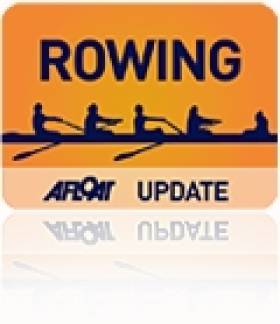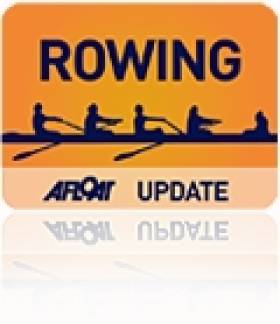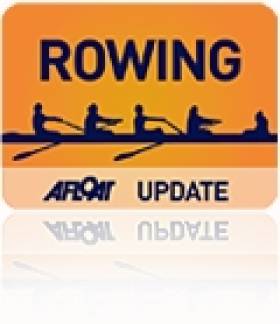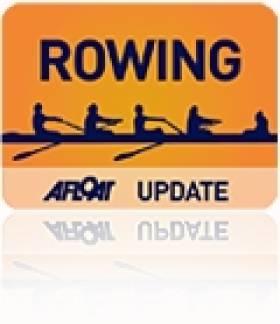Displaying items by tag: Korea
Campbell Denied Medal at World Rowing As Cuban Takes Surprise Silver
#WRChamps: In a terrifically exciting final of the men’s single sculls at the World Rowing Championships, Alan Campbell had to settle for fourth. Ondrej Synek of the Czech Republic was an impressive winner of the gold, but Angel Fournier Rodriguez of Cuba passed both Marcel Hacker (the eventual bronze medallist) and Campbell in the second half of the race to take a surprise silver.
World Rowing Championships, Chungju, Korea, Day Eight (Irish interest)
Men
Single Sculls – A Final: 1 Czech Republic (O Synek) 6:45.24, 2 Cuba (A Fournier Rodriguez) 6:48.91, 3 Germany (M Hacker) 6:49.39; 4 Britain (A Campbell) 6:51.44, 5 Netherlands 6:52.70, 6 Lithuania 6:56.19.
Women
Double Sculls – A Final: 1 Lithuania 6:51.82, 2 New Zealand 6:51.86, 3 Belarus 6:55.90; 4 Britain 6:58.67, 5 Germany 7:00.66, 6 Denmark 7:04.72.
B Final (Places 7 to 12): 1 United States (M O’Leary, E Tomek) 6:56.05, 2 Russia (E Potapova, M Kraskilnikova) 7:01.07, 3 Ukraine (A Kravchenko, O Buryak) 7:03.34, 4 Ireland (M Dukarksa, L Kennedy) 7:06.80, 5 Italy 7:09.04, 6 Korea 7:11.75.
Saturday
Men
Lightweight Double Sculls: 1 Norway 6:36.04, 2 Switzerland 6:37.11, 3 Britain (R Chambers, P Chambers) 6:38.04.
Tenth in World Rowing for New Crew of Kennedy and Dukarska
#WRChamps: Ireland had a good finish to its campaign in the World Rowing Championships in Chungju in Korea this morning. The new women’s double scull of Monika Dukarska and Leonora Kennedy took fourth in their B Final, tenth overall in this Olympic-class event. Meghan O’Leary and Ellen Tomek of the United States won the contest at the head of the field with Russia and the Ukraine, and the Irish won their battle with Italy and Korea. Italy pushed hard at the 1500-metre mark; Kennedy and Dukarksa saw them off with a good final quarter.
World Rowing Championships, Chungju, Korea, Day Eight (Irish interest)
Women
Double Sculls – B Final (Places 7 to 12): 1 United States (M O’Leary, E Tomek) 6:56.05, 2 Russia (E Potapova, M Kraskilnikova) 7:01.07, 3 Ukraine (A Kravchenko, O Buryak) 7:03.34, 4 Ireland (M Dukarksa, L Kennedy) 7:06.80, 5 Italy 7:09.04, 6 Korea 7:11.75.
Ireland's New Women's Double Fifth in World Rowing Semi-Final
#WRChamps: Ireland’s new double scull of Leonora Kennedy and Monika Dukarska finished fifth in their semi-final at the World Championships in Chungju in Korea this morning and will compete in a B Final on Sunday. The semi-final was won well by Frances Houghton and Victoria Meyer-Laker, with Germany and Denmark filling second and third and taking the resultant places in the A Final. Ukraine took fourth, while Ireland pushed Italy into sixth early in the race and stayed in front of the crew in blue until the finish.
World Rowing Championships, Chungju, Korea, Day Six (Irish interest)
Women
Double Sculls – Semi-Final (First Three to A Final; rest to B Final): 1 Britain (F Houghton, V Meyer-Laker) 7:18.56, 2 Germany (J Lier, M Adams) 7:19.10, 3 Denmark (M Petersen, L Jakobsen) 7:29.30; 4 Ukraine 7:34.27, 5 Ireland (M Dukarska, L Kennedy) 7:39.33, 6 Italy 7:39.50.
Lightweight Single Sculls – C Final (Places 13 to 18): 1 Italy (D Zacco) 8:05.21, 2 Ireland (C Lambe) 8:07.38, 3 Korea (Yoo Jin Ji) 8:08.75, 4 Japan 8:18.46, 5 Singapore 8:24.11, 6 India 8:32.05.
Lambe Denied by Italy's Zacco at World Rowing Championships
#WRChamps: Italy’s Denise Zacco denied Claire Lambe a win in the C Final of the lightweight single sculls at the World Rowing Championships in Chungju in Korea. Lambe led through the first three quarters of the 2,000 metres, but Zacco judged the race superbly: by 1500 metres she had passed Yoo Jin Ji of Korea; she closed on Lambe, then passed her in the last 200 metres.
World Championships, Day Six (Irish interest)
Women
Lightweight Single Sculls – C Final (Places 13 to 18): 1 Italy (D Zacco) 8:05.21, 2 Ireland (C Lambe) 8:07.38, 3 Korea (Yoo Jin Ji) 8:08.75, 4 Japan 8:18.46, 5 Singapore 8:24.11, 6 India 8:32.05.
Kennedy and Dukarska Give Ireland Place in World Championship Semis
#WRChamps: Monika Dukarska and Leonora Kennedy reached the A/B Semi-Finals at the World Championships in Korea this morning. The Ireland double scull had to make the top three in their repechage to qualify, and they finished second behind Russia and ahead of Korea, who took the third qualification place. The Russians, who had to give way to Ireland in the heats, were pillar-to-post winners, but the new Ireland crew maintained a steady pace behind them.
The Olympic and World Champion in the men's single sculls, Mahe Drysdale of New Zealand, could only finish fourth in his quarter-final and failed to make the semi-finals.
World Rowing Championships, Day Three (Irish interest)
Women
Double Sculls – Repechage (First Three to A/B Semi-Finals; rest to C Final): 1 Russia (E Potapova, M Krasilnikova) 7:09.81, 2 Ireland (M Dukarska, L Kennedy) 7:12.08, 3 Korea (A Kim, Y Kim) 7:17.95; 4 Taipei 7:44.92, 5 Namibia 9:22.05.
Lambe Misses Out By Single Second On A Final Chance
#WRChamps: Claire Lambe missed out by less than a second on a chance of competing in the A or B Finals at the World Rowing Championships in Chungju in Korea. The Dubliner needed to finish in the top two in the repechage, and contested second place with Australia’s Ella Flecker, but the Australian prevailed by .9 of a second. Patricia Obee of Canada finished ahead of both. Lambe must next compete in a C/D Semi-Final.
World Rowing Championships, Day Three (Irish interest)
Women
Lightweight Single Sculls – Repechage (First Two to A/B Semi-Finals; Rest to C/D Semi-Final): 1 Canada (P Obee) 7:38.35, 2 Australia (E Flecker) 7:42.73; 3 Ireland (C Lambe) 7:43.63, 4 Italy 7:47.10, 5 Korea 7:52.30, 6 India 8:25.62.
Good Second Half Not Enough for Ireland Women's Double
#WorldRowingChampionships: Ireland’s double scull of Monika Dukarska and Leonora Kennedy took fourth in their heat at the World Rowing Championships in Chungju in Korea this morning and must compete in a repechage to secure a place in the A/B Semi-Finals.
A place in the top three was the target: Lithuania and Denmark were the clear one-two from half way, with Ukraine in third and Ireland and Russia trailing. Dukarska and Kennedy upped their rate in the second half of the race, engaging in a battle with Russia which they won. They overlapped Ukraine in the closing stages but could not head them.
World Rowing Championships, Day Two (Irish interest)
Women
Double Sculls – Heat One (First Three Directly to A/B Semi-Final; rest to Repechage): 1 Lithuania (D Vistartaite, M Valciukaite) 6:52.09, 2 Denmark (M Petersen, L Jakobsen) 6:56.34, 3 Ukraine (A Kravchenko, O Buryak) 7:02.42; 4 Ireland (M Dukarska, L Kennedy) 7:03.92, 5 Russia 7:09.73.
Rowing Ireland Sends Two Boats to World Championships
#World Rowing: Ireland will send two crews to the World Rowing Championships in Chungju in South Korea. Claire Lambe will compete in the lightweight single sculls, while Monika Dukarska and Leonora Kennedy will compete in the double. In their last outing Lambe finished fifth at the World Cup regatta in Dorney and the Dukarska and Kennedy sixth. This was the double’s first outing as a crew.
The Championships run from Sunday, August 25th, to the following Sunday, September 1st.
Ireland Team for World Rowing Championships, Chungju, South Korea, August 25th to September 1st
Women
Double Sculls: M Dukarska, L Kennedy
Lightweight Single Sculls: C Lambe





































































